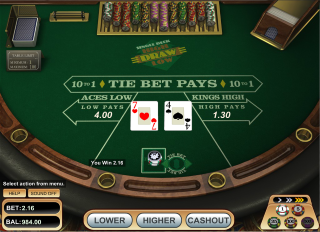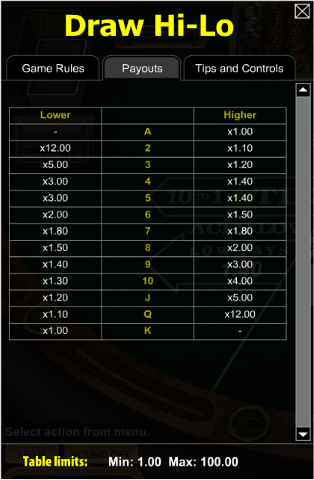On this page
Draw Hi-Lo
Introduction
Draw Hi-Lo could most closely be compared to the classic version of Genie's Hi Lo. It is a simple game where the player bets whether the next card in the deck will be higher or lower than the current card. The odds are roughly commensurate with the probability of winning. The game is made by Betsoft, which provides software to Internet casinos.
Rules
- The game is played with a single 52-card deck. Cards are ranked as in poker, except aces are always low.
- Cards are not replaced back in the deck after use. In other words, the player won't see the same card twice in the same game.
- The player is given a random card. As long as the decision isn't obvious, the player will be given the choice to bet whether the next card will be higher or lower.
- If the player is correct, then he will be paid according to the pay table below. In the event of a tie, the bet shall push. In the event the player guesses incorrectly, then he will lose.
- Except for the first decision, the player may quit at any time and collect his winnings to that point.
Error in Help File
I'm sure that if I didn't address this, then everybody and his brother would write to me and tell me that I'm in error about the win for betting higher than a 4 being 1.3, as evidenced by the screenshot of the game pay table above saying it pays 1.4.
I'm taking a stand that this pay table is in error. For one thing, the mirror opposite bet of under 10 pays 1.3. For another, you can see in the screenshot at the top of the page that the win offered for higher than 4 is 1.3. Finally, I played until the situation occurred, and I was paid 1.3x. So please do not write to me about this.
Strategy
The following table shows the basic strategy for the non-card-counter, which strives to maximize expected value, as opposed to probability of survival.
Draw Hi-Lo Strategy
| Card | Play |
|---|---|
| 2 | H |
| 3 | H |
| 4 | L |
| 5 | L |
| 6 | QH |
| 7 | QE |
| 8 | QL |
| 9 | H |
| 10 | H |
| J | L |
| Q | L |
Key to Table:
- H = Higher
- L = Lower
- QH = Quit if allowed, otherwise pick Higher
- QL = Quit if allowed, otherwise pick Lower
- QE = Quit if allowed, otherwise it doesn't make any difference
Basic Strategy Analysis
The following table shows the probability and expected return of the betting Higher, for the non-card-counter.
Higher Analysis
| Card | Pays | Prob. Win | Exp. Ret. |
|---|---|---|---|
| 2 | 1.1 | 0.916667 | 1.008333 |
| 3 | 1.2 | 0.833333 | 1.000000 |
| 4 | 1.3 | 0.750000 | 0.975000 |
| 5 | 1.4 | 0.666667 | 0.933333 |
| 6 | 1.5 | 0.583333 | 0.875000 |
| 7 | 1.8 | 0.500000 | 0.900000 |
| 8 | 2 | 0.416667 | 0.833333 |
| 9 | 3 | 0.333333 | 1.000000 |
| 10 | 4 | 0.250000 | 1.000000 |
| J | 5 | 0.166667 | 0.833333 |
| Q | 12 | 0.083333 | 1.000000 |
The following table shows the probability and expected return of the betting Lower, for the non-card-counter.
Lower Analysis
| Card | Pays | Prob. Win | Exp. Ret. |
|---|---|---|---|
| 2 | 12 | 0.083333 | 1.000000 |
| 3 | 5 | 0.166667 | 0.833333 |
| 4 | 4 | 0.250000 | 1.000000 |
| 5 | 3 | 0.333333 | 1.000000 |
| 6 | 2 | 0.416667 | 0.833333 |
| 7 | 1.8 | 0.500000 | 0.900000 |
| 8 | 1.5 | 0.583333 | 0.875000 |
| 9 | 1.4 | 0.666667 | 0.933333 |
| 10 | 1.3 | 0.750000 | 0.975000 |
| J | 1.2 | 0.833333 | 1.000000 |
| Q | 1.1 | 0.916667 | 1.008333 |
The following table shows the probability and expected return for making the play with the greater expected value at all points for the non-card-counter.
Basic Strategy Player Analysis
| Card | Best Play | Pays | Prob. Win | Exp. Ret. |
|---|---|---|---|---|
| 2 | H | 1.1 | 0.916667 | 1.008333 |
| 3 | H | 1.2 | 0.833333 | 1.000000 |
| 4 | L | 4 | 0.250000 | 1.000000 |
| 5 | L | 3 | 0.333333 | 1.000000 |
| 6 | QH | 1.5 | 0.583333 | 0.875000 |
| 7 | QE | 1.8 | 0.500000 | 0.900000 |
| 8 | QL | 1.5 | 0.583333 | 0.875000 |
| 9 | H | 3 | 0.333333 | 1.000000 |
| 10 | H | 4 | 0.250000 | 1.000000 |
| J | L | 1.2 | 0.833333 | 1.000000 |
| Q | L | 1.1 | 0.916667 | 1.008333 |
In the table above, you can see the expected returns are less than 100% for the middle cards of 6, 7, and 8. For that reason, you should quit, unless it is your first turn, in which case you're forced to play.
Following the basic strategy, the return, measured as the ratio of the player's expected final win to his initial bet, is 96.07%.
This figure was based on a simulation that ended when the player quit, lost, increased his original wager to 100x the initial amount (to add some realism), or the game ran out of cards.
Card Counting
It would not be difficult to track the number remaining of each rank to determine the exact probability of both Higher and Lower winning. From there, the player can make a perfect decision of which way to go, or quit.
Following such a card-counting strategy, the return, measured as the ratio of the player's expected final win to his initial bet, is 100.36%! Who else gives you positive plays like this on a silver platter?






